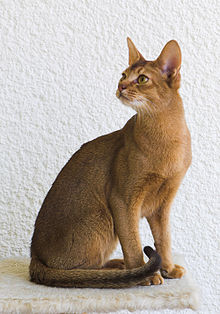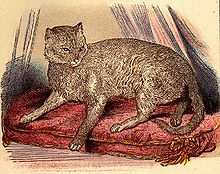The Highlander cat is a deliberate cross between the Desert Lynx and the Jungle Curl breeds
Aegean
The Aegean is a cat of Greek origin that has been developed since the 1990s by the Feline Federation of Greece, using cats from the Cyclades.[citation needed] The name 'Aegean' comes from the fact that the cats were originally found around the Aegean Sea.[2] They are considered a national treasure of Greece.[2] Aegean cats are a landrace, and are one of the oldest distinct populations of the domestic cat.[2] They have an affinity for fishing and water, and are numerous in Greek fishing ports.[2] It is a medium-sized, muscular cat[2] with a lighter European or Continental type body,[citation needed] medium-sized round paws, and green almond-shaped eyes.[2] The coat is always two or three colors, one of which is always white.[2] The breed is mostly free from common feline diseases.[2]
American Polydactyl
The American Polydactyl is a polydactyl cat, meaning that it has more than the usual number of toes. This breed is currently in development. As of 2018, it is recognized (since 2004) only by the Rare and Exotic Feline Registry.[5]
https://en.wikipedia.org/wiki/List_of_experimental_cat_breeds
https://en.wikipedia.org/wiki/Natural_bobtail
https://en.wikipedia.org/wiki/Eurasian_lynx
https://en.wikipedia.org/wiki/List_of_experimental_cat_breeds
https://en.wikipedia.org/wiki/Polydactyl_cat
https://en.wikipedia.org/wiki/Persian_cat
https://en.wikipedia.org/wiki/Burmilla
https://en.wikipedia.org/wiki/Bengal_cat
https://en.wikipedia.org/wiki/Burmese_cat
https://en.wikipedia.org/wiki/Ocicat
https://en.wikipedia.org/wiki/Tabby_cat
https://en.wikipedia.org/wiki/Caracal
https://en.wikipedia.org/wiki/Sphynx_cat
https://en.wikipedia.org/wiki/Foldex_cat
https://en.wikipedia.org/wiki/Genet_(animal)
https://en.wikipedia.org/wiki/Highlander_cat
https://en.wikipedia.org/wiki/Felid_hybrid
https://en.wikipedia.org/wiki/Jungle_cat
https://en.wikipedia.org/wiki/Tonkinese_cat
https://en.wikipedia.org/wiki/Abyssinian_cat
https://en.wikipedia.org/wiki/Black_panther
https://en.wikipedia.org/wiki/Leopard_cat
https://en.wikipedia.org/wiki/Pixie-bob
https://en.wikipedia.org/wiki/Maine_Coon
https://en.wikipedia.org/wiki/Asiatic_wildcat
https://en.wikipedia.org/wiki/Geoffroy%27s_cat
https://en.wikipedia.org/wiki/Rex_mutation
https://en.wikipedia.org/wiki/LaPerm
The Ocicat is an all-domestic breed of cat which resembles a wild cat but has no recent wild DNA in its gene pool. The breed is unusual in that it is spotted like a wild cat but has the temperament of a domestic animal. It is named for its resemblance to the ocelot. The breed was established from the Siamese and Abyssinian. American Shorthair was also added to the original crosses due to an error in the Cat Fanciers' Association, Inc's recording of the breeds used. This mix of breeds created a healthy, large breed of cat completely different in type and appearance from the source breeds.
https://en.wikipedia.org/wiki/Ocicat
| Abyssinian | |
|---|---|
 A male ruddy Abyssinian | |
| Common nicknames | Abys |
| Origin | Indian Ocean, Southeast Asia[1] |
| Breed standards | |
| CFA | standard |
| FIFe | standard |
| TICA | standard |
| ACF | standard |
| CCA-AFC | standard |
| GCCF | standard |
| Domestic cat (Felis catus) | |
https://en.wikipedia.org/wiki/Abyssinian_cat
| Sokoke | |
|---|---|
 Neutered male Sokoke cat | |
| Other names | Sokoke Forest Cat, African Shorthair (standardised breed); khadzonzo or kadzonzo (original landrace) |
| Origin | Kenya, Denmark, United States (std. breed); Kenya (landrace) |
| Foundation bloodstock | Std. breed developed from landrace cats, ultimately of Asian origin |
| Breed standards | |
| FIFe | standard |
| CCA-AFC | standard |
| Domestic cat (Felis catus) | |
https://en.wikipedia.org/wiki/Sokoke
https://en.wikipedia.org/wiki/Felidae
https://en.wikipedia.org/wiki/Hybrid_(biology)#Hybrid_animals
Relation to other populations
Couffer hypothesises that, due to their isolation and Lamu's ancient history as a trade centre between Africa and Asia, they may be more closely related than even the Egyptian Mau breed to the original cats domesticated in the Fertile Crescent over 4,000 years ago and holding special favour in Ancient Egypt[5]
While modern genetic work has yet to prove or disprove Couffer's idea, a DNA study by the Cat Genome Project (CGP) at the US National Cancer Institute has determined that the spotted khadzonzo street cats of eastern Kenya, the cats of the Lamu Archipelago off the Kenyan coast, and the standardized Sokoke are all closely related.[6] CGP categorised them in its "Arabian Sea Racial Group" (among a total of 12 feline "race" groupings).[7] The group's shared DNA is derived primarily from Asian domestic cats, with ancient Arabian wildcat progenitors.[citation needed] This dispels the suspicion of some breeders[3] that the cats are at least part modern wildcat – they are no more wild than the rest of the domestic cats. Advances in DNA sequencing have now resulted in an ambitious whole-body sequencing effort, called the 99 Cat Genome Project, which may reveal much more about the origins of the khadzonzo and connections that it and the Sokoke has with other cat populations.[citation needed]
https://en.wikipedia.org/wiki/Sokoke



No comments:
Post a Comment